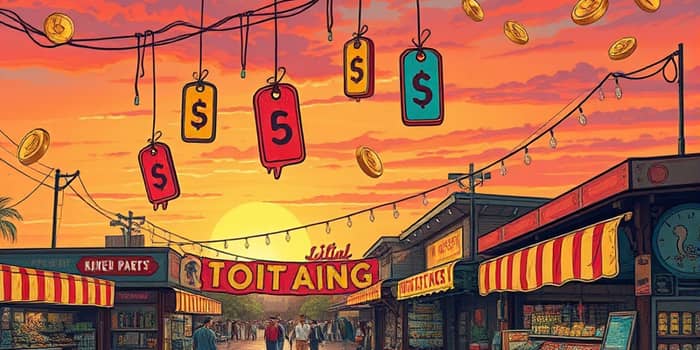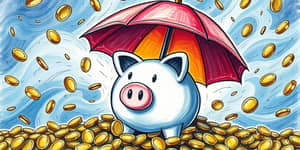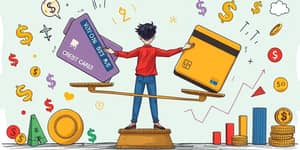Inflation touches every aspect of your daily life, from the groceries you buy to the interest you pay on loans. Understanding its drivers and consequences is essential for preserving the value of your hard-earned money and making informed financial decisions.
Definition and measurement of inflation
At its core, inflation is the rate at which the general level of prices for goods and services rises over a given period. Economists rely on price indices to track this movement, most notably the Consumer Price Index (CPI) and the Wholesale Price Index (WPI). Each index uses a basket of goods with assigned weights to reflect typical household or producer spending patterns.
The CPI measures the average change in prices paid by urban consumers for a range of items, including food, housing, and transportation. In contrast, the WPI focuses on the prices received by producers, capturing early inflationary signals.
When inflation is positive, each unit of currency buys fewer goods and services than before; this is known as erosion of purchasing power over time. If prices decline instead, deflation sets in, potentially stalling economic growth and increasing the real burden of debt.
Types and causes of inflation
Inflation does not manifest uniformly; different forces can push prices upward in distinct ways.
- Demand-pull inflation: Occurs when aggregate consumer demand surpasses available supply, often during economic expansions when employment and incomes rise.
- Cost-push inflation: Triggered by rising production costs, such as raw materials or labor expenses. Supply chain disruptions can intensify this effect, as seen during major global events.
- Built-in inflation: Fueled by adaptive expectations when businesses and workers anticipate higher costs and adjust wages and prices accordingly, creating a self-fulfilling cycle.
Several underlying factors amplify these types. An increase in the money supply, typically through expansionary monetary policy and low interest rates, puts more currency in circulation, driving higher demand. Governments may also inject cash into the economy via stimulus measures.
External shocks—such as oil crises, geopolitical conflicts, or pandemics—can push up energy and commodity prices, leading producers to pass on higher costs to consumers. Changing consumer expectations can further intensify inflation if people start purchasing in anticipation of future price hikes.
For example, the oil shocks of the 1970s led to severe cost-push pressures worldwide, while rapid post-pandemic recovery spending in 2021 strained global supply chains, contributing to a surge in price indices across many countries.
Effects of inflation on your money
Inflation’s reach extends beyond retail prices; it reshapes financial outcomes for households, investors, and policymakers.
Erosion of purchasing power: As prices climb, cash holdings lose value. Consider a simple illustration: a basket of goods costing $100 today may cost $106 a year from now if inflation runs at 6 percent. For someone on a fixed budget, this means fewer essentials or a need to dip into savings.
People on fixed incomes, such as retirees relying on pensions, can feel this squeeze acutely. Without cost-of-living adjustments tied to inflation, their real income and quality of life may decline.
Impact on wages and income: When wages rise slower than inflation, real earnings fall. During the 1970s U.S. inflation peak, nominal wages rose by double digits, but stubbornly high price growth still left many workers worse off.
Conversely, in a wage-price spiral, businesses facing higher payroll costs increase prices to maintain profit margins, further fueling inflation. Breaking this cycle often requires tough policy choices.
Effect on savings and investments: Inflation diminishes the real value of savings if return rates fail to keep pace. For instance, a savings account with a 1.5 percent annual interest rate loses ground when inflation runs at 3 percent.
Investors often pivot to stocks, real estate, or inflation-indexed bonds to seek returns that outpace rising prices. However, these assets carry their own risks, including market volatility and liquidity constraints.
Interest rate dynamics: Central banks typically respond to high inflation by hiking policy rates. While higher rates cool demand and dampen price pressures, they also raise borrowing costs for mortgages, auto loans, and credit cards.
Variable-rate debt becomes more expensive, increasing monthly payments. Homebuyers may delay purchases, and businesses might postpone expansion plans in the face of steeper financing costs.
Asset price fluctuations: Tangible assets like real estate and precious metals are often viewed as inflation hedges. Home prices generally rise alongside higher construction and land costs, preserving wealth in nominal terms.
Conversely, bonds with fixed coupons can suffer. If market yields outpace a bond’s interest payments, its price falls, reflecting the lower real value of future cash flows.
Supply chain and production costs: When raw material prices spike, manufacturers pass expenses onto consumers. Persistent shortages in semiconductors, for example, have led to higher electronics and automotive prices over recent years.
Economic uncertainty: Unpredictable price movements undermine long-term planning. Businesses may delay capital investments, and consumers might reduce big-ticket purchases. This uncertainty can dampen growth and prolong economic recoveries.
Summary of inflation’s impacts
How inflation is controlled
Central banks are the primary guardians against runaway inflation, employing a toolkit designed to balance growth with price stability. The Federal Reserve, European Central Bank, and others adjust policy rates and conduct open market operations to influence borrowing and spending.
When inflation exceeds targets—often around 2 percent annual growth target—monetary authorities may raise interest rates, making loans more expensive and dampening demand. They can also sell government bonds to remove excess liquidity from the banking system.
Fiscal policy can complement these efforts. Governments may reduce spending or increase taxes to cool overheated economies. Regulatory measures, such as adjusting reserve requirements for banks, can further tighten credit conditions.
Coordinated action between monetary and fiscal authorities helps ensure that inflation expectations remain anchored, preventing self-fulfilling spirals in wages and prices.
Practical tips for managing your finances during inflation
- Track whether your income is keeping pace with rising prices.
- Diversify investments to include assets historically outperforming inflation, such as equities or real estate.
- Explore inflation-protected securities like Treasury Inflation-Protected Securities (TIPS).
- Review debt agreements for rate reset terms on variable-rate loans.
- Maintain an emergency fund in accounts balancing liquidity and yield.
- Negotiate salary reviews or seek cost-of-living adjustments.
By adopting these strategies, you can mitigate the adverse effects of inflation and position your portfolio to grow in real terms over time.
Concluding thoughts
Inflation is neither inherently good nor bad; rather, its impact depends on its rate and volatility. Moderate inflation can signal a healthy, growing economy, while excessive or unpredictable price increases distort markets and erode living standards.
Historical patterns—from the hyperinflation of the Weimar Republic to the deflationary challenges of Japan—demonstrate the importance of balanced policy responses. Expectations play a pivotal role: when consumers and businesses anticipate stable prices, they plan and invest with confidence.
Staying informed about inflation trends, understanding central bank policy, and adopting adaptive financial strategies can help you maintain purchasing power and achieve long-term goals, even as economic conditions evolve.
References
- https://www.imf.org/en/Publications/fandd/issues/Series/Back-to-Basics/Inflation
- https://en.wikipedia.org/wiki/Inflation
- https://www.investopedia.com/terms/i/inflation.asp
- https://gisme.georgetown.edu/news/what-the-hell-is-inflation-anyway/
- https://www.mckinsey.com/featured-insights/mckinsey-explainers/what-is-inflation
- https://www.jrmartincpa.com/how-does-inflation-influence-purchasing-power/
- https://www.quickenloans.com/learn/effects-of-inflation
- https://www.youtube.com/watch?v=HQ-Kg_xgdhE










